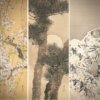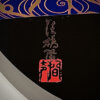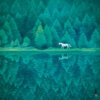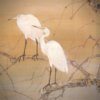Kishi Chikudō: The Last Great Master of the Kishi School Who Created a New Style of Japanese Painting Integrating the Techniques of Western Painting
Japanese Maple Tree and Small Birds
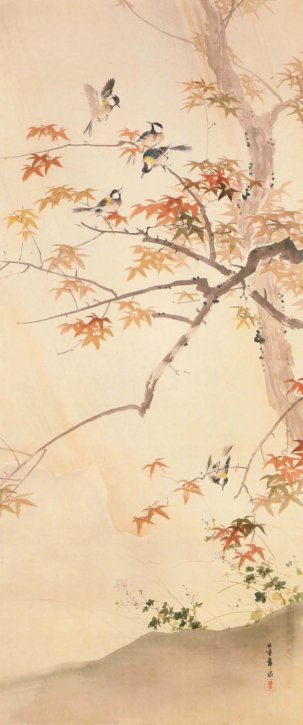
Kishi Chikudō was born in 1826 in Hikone Castle town as a child of the Hikone feudal warrior. His father had a great talent for martial arts. Since Kishi Chikudō spent so much time drawing, his father decided to leave him with Nakajima Antai, an official painter of the Hikone domain. After several years of studying under Antai, he moved to Kyoto to study under Kanō Eigaku, where he could not be satisfied since what he learned there was just a formality. Next, he was apprenticed to Kishi Renzan who was very active in Kyoto at the time. After almost 10 years of training, he was adopted by Renzan and eventually succeeded the fourth-generation master of the Kishi school. Most painters except literati who engaged in literati painting were in a difficult time for the first ten years of the Meiji period. Having hit a bad patch, financially, Chikudō tried for some paid work with rough drafts of Yuzen Kimono. Even under such circumstances, Chikudō devoted himself to sketching, digested the perspective of Western-style paintings, and created highly individualistic expressions, which earned him the reputation as the father of modern Japanese-style painting in the Kyoto art world. However, his life had been full of ups and downs. He died in 1897 at the age of 72.
“Japanese maple tree and small birds” is a subject that Chikudō often painted. The maple leaves are turning red as autumn is in full swing. In the lower part of the painting, Chikudō depicted a wild chrysanthemum swaying in the rain on the ground. A playful flock of coal tits is surprised by the sudden rain shower. Although this painting depicts a scene commonly seen in the fields and mountains of late autumn in Japan, it clearly shows the individuality of Chikudō, who was devoted to sketching. This painting carefully depicts the subtle differences between the overlapping leaves of the autumn maple tree, and even the appearance of the coal tits flying from the branches to the branches are drawn based on a very careful observation. At one point, Chikudō was drawing rough drafts of Yuzen Kimono, so he should have been good at gorgeous paintings. However, “Maple tree and small bird” is done with no superfluous decoration. Shigure / Autumn cold rain is often drawn as a theme that expresses the changing seasons from autumn to winter. Here it plays the role of the background of the flower-and-bird painting.
Flowering Plants and Birds
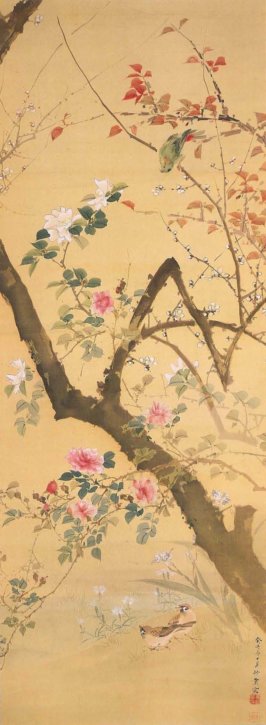
Chikudō was a painter who devoted himself to sketching. It is said that he made many preliminary sketches of his paintings until he was satisfied, then went for the real product. He used to insist that a painter should always carry a yatate (a portable brush and ink), just as a samurai always carries two swords, and that it is important to be mindful of capturing the changes in the universe that happen from time to time. The Kishi school had excelled at painting “tigers” for generations, but Chikudō did not rely on traditional painting samples of the school and drew a dynamic and fierce tiger, utilizing his experience of sketch after sketch. He had been a perfectionist about the composition of the tiger painting, and he had almost gone insane. The flower-and-bird paintings by Chikudō show that he was a creative artist who took a keen interest in composition, rather than just a perfectionist. Here too, the brush strokes of flowers, trees, birds, and animals that Chikudō acquired through his sketching can be fully observed.
“Flowering plants and birds” is a work by Chikudō when he was 28 years old. This is a work from his early career, and a truly delightful painting. It depicts a largely bent plum tree in the center, crossed by flowering trees with climbing roses and camellia sasanqua, and their blossoms. On the ground below, white flowers of iris japonica and Japanese Dianthus are blooming, and two sparrows are playing with each other. In the upper part of the painting, a parrot tilts its neck on a twig of plum blossoms. Both the sparrow and the parrot are lively depicted in this work, which truly shows Chikudō’s painting style, devoted to sketching.
He became a disciple of Kishi Renzan when he was 18 years old, so he drew “Flowering plants and birds” after 10 years of training. It was the same year he became Renzan’s adopted son. You can see the result of absorbing Renzan’s method of brush techniques, who excelled in flower-and-bird paintings. From this point until he was about 50 years old, Chikudō cleverly adopted the rules of perspective drawing in Western art. Although he struggled with it, he was able to digest it well. This painting owes much to the flower-and-bird painting style fostered by the Kishi school from its founder, Saeki Ganku. However, the depiction of flowering plants and birds foreshadows a new path of Chikudō, devoted to sketching.
He made the technique his own. In this painting, you can see many techniques of flower-and-bird paintings which the ancestor of Kishi school, Saeki Ganku, had made, but you can see the future development of Kishi Chikudō in the depictions of flowers, trees, and birds.
Little Birds in Early Autumn / Maple Tree and Little Birds
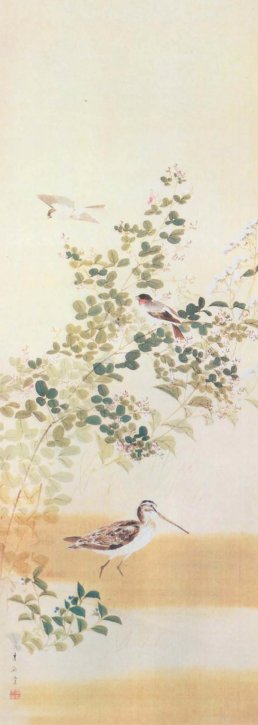
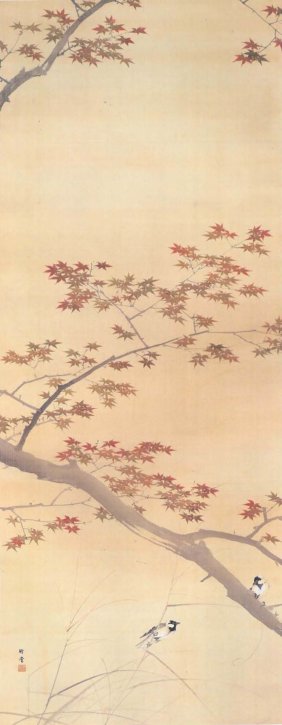
Initially, Kishi Chikudō learned painting from a local Kanō school painter, Nakajima Antai. Next, he went to Kyoto to study under Kanō Eigaku. He stayed there only for a year because he couldn’t be satisfied with the fixed ideas of painting subjects and formalized painting techniques, that are based on the school’s traditional painting samples. Thus, he then became a disciple of Kishi Renzan. With ten years of intense training, Chikudō worked his way up to the fourth generation of the Kishi school. The Kishi school is still a new and youthful school of painting since the first generation, Saeki Ganku. They devised their painting style by incorporating the painting techniques of the Nagasaki school and Chinese Song dynasty painting into the sketches of the Maruyama school. Chikudō added a Western-style painting technique to it and began to draw splendid flower-and-bird paintings based on sketches. When Chikudō went out, he constantly had a yatate (a portable brush and ink) with him as he was eager to make a sketch. He worked on the sketches until he was completely satisfied, and then continued improving the preliminary sketches until he believed that they are the best they can be. He sometimes went mad because of his innate stiffness. Chikudō, a pioneer in the modernization of Japanese painting, was appointed to Teishitsu Gigei-in (imperial household artist) at the age of 71, and the following year, he died in 1897. He looked like a countryside man, but many of the flower-and-bird paintings he drew were sophisticated and elegant.
The “Little birds in early Autumn” depicts the flowering plants and birds on the edge of the water in the autumn. You can see the high level of technique that makes you feel Chikudō who devoted himself to sketching, from the sandpiper underwater, the bullfinch stopping on the bush clover and the sparrow that flew away from the flowers. The dew grass has pretty flowers on the soil near the water, and the blooming of the flowers such as bush clover spreading in the center of the painting, the subtle changes in the color of the leaves, etc. are drawn through the sharp eyes and brush of Chikudō. The autumn atmosphere in the great outdoors is refreshing. There seems to be a reed field behind the brightly colored sandpiper.
“Maple tree and little birds” is typical Chikudō too. The bright red maple branches form a large rhombus shape in the painting. Japanese pampas grass, extending from the bottom is swaying in the autumn breeze. Great tits are playing on the thick maple branches and the stem of Japanese pampas grass. The ears of Japanese pampas grass are still thin, probably because it is a painting depicting the mountains in early autumn. The maple’s autumn leaves are also beginning to turn red only at the tip. The maple branches are also drawn lightly. Chikudō also drew sketches of Yūzen dyeing, so it would have been possible for him to paint a decorative and gorgeous design with a brush if he tried, but on the other hand, the simple drawing with a spirituality like this “Maple tree and little birds” is also the world of Chikudō’s. Just as a samurai carries swords, the painter always carries Yatate, sketching everything and the ever-changing phenomena of nature. “Maple tree and little birds” depicts the subtle changes in the appearance of nature. That is what Chikudō always insisted on. The maple with red-turned leaves is just beautiful. However, this painting, which expresses the providence of nature, with the leaf gradually turning red from the tip, makes you feel a glimpse of the mystery of nature.
Flowering Plants
Kishi Chikudō told his disciple, “Whenever you paint on silk, it is important to draw it upright. Never put it on the floor. That is because people watch the paintings that are being put upright.” Drawing upright requires a great deal of training and skill, and it depends on the practice whether or not a single line moves vividly. Chikudō’s drawing attitude is also shown in this painting, which can be seen in the relaxed lines of autumn grasses. Chikudō was enthusiastic about research, and he seems to have a wide knowledge of various old paintings. In this painting as well, a decorative atmosphere is expressed by intense nature observation, showing an expression familiar to the Rinpa style.
Flower-and-Bird Painting (Peacock)
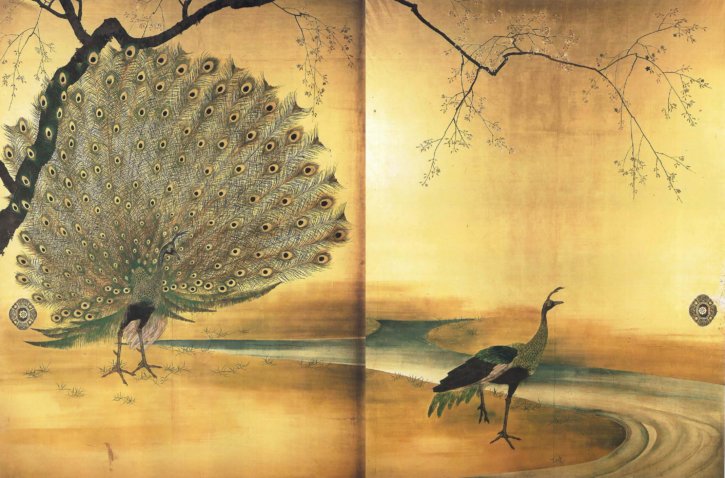
The peacock was the theme that expresses the most luxurious and splendid atmosphere among the flower-and-bird paintings and has been worked on by realism painters in Kyoto after Ōkyo. The appearance of the fully spread peacock tail feathers must have attracted the interest of painters who specialize in sketching. It is a flower-and-bird painting of peacocks expressed in vivid colors on gold. It is not flashy, but rather a calm and quiet painting. The cherry blossoms also look lonely. Chikudō may have tried to express another side of the peacock that exists behind the gorgeousness, as opposed to the gorgeousness that the conventional peacock paintings had shown. Around 1892, Chikudō was devoted to the depiction of the tigers’ glare, and once fell into a state of confusion, saying, “the tiger glared at me.” Since the production of this painting was after that event, Chikudō might have been less impressed with the gorgeousness of the peacock then. On the contrary, he tried to watch the peacock calmly.
Wild Cherry and Small Bird / Small Birds in Early Spring
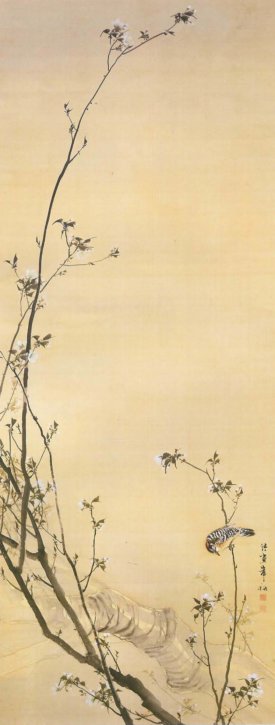
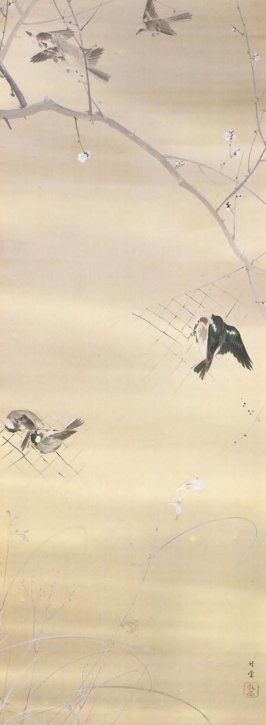
Kishi Chikudō went to Kyōto at the age of 17 and studied under Kanō Eigaku who was a Kyōto Kanō school painter (Kanō school patronized by the Imperial court in Kyōto.) but became unsatisfied with the traditional Kano school world that placed great emphasis on learning books and models. After about a year, he became a disciple of Kishi Renzan. Chikudō described his feelings as follows.
“Kanō school does not interact with the real nature. It can’t grasp the truth of nature. There is no real excitement or real passion. There is a lurking joy that burns more. I did want to meet things that have a joy that burns. I want to learn paintings like that and make my soul excited.”
He lived in Kishi Renzan’s house as a private disciple and practiced drawing hard. As a result, he succeeded the Kishi family, pushing aside Renzan’s child, Kishi Kyūgaku. Since Saeki Ganku (the founder of the Kishi school), the Kishi school has adopted disciples who were excellent painters and had them take the Kishi family name. Renzan followed this tradition and chose Chikudō as his successor. Chikudō, who abandoned the Kano school’s old principles, focused on sketching and was into it. From the end of the Edo period to the Meiji period, Kyōto was involved in political upheaval, and the Kyoto art world was truly in dark times. Although Chikudō inherited the name of Renzan, he struggled to make ends meet. He undertook many unfamiliar jobs, but failed in all of them, so he made a living by making a draft for Yuzen Kimono. However, in his later years, Chikudō worked his way to be elected as a Teishitsu Gigei-in (imperial artist) and became a master of the Kyōto art world. Yet, in creating the painting of the tiger, which is Kishi school’s specialty, Chikudō went crazy because working on the expression of the tiger’s eye was nerve-wracking. He shouted, “The tiger was staring at me.”
Looking at the two paintings, we can see Chikudō’s mind was extremely tense.
In the “Wild cherry and small birds”, the branches of the wild cherry whose color blurs from bottom to top, are rendered as thin brush strokes with a feeling of tension.
In the painting “Small birds in early spring,” fowling nets are set into the branches of a flowering plum tree, enabling the viewer to turn their attention toward the birds.
These two paintings are not flower-and-bird paintings done by a painter with common sense.
He got too nervous about the expression in the tiger’s eyes and could not keep sane. The experience helped Chikudō show great sensibility and brought his paintings to another level apart from other flower-and-bird paintings.



